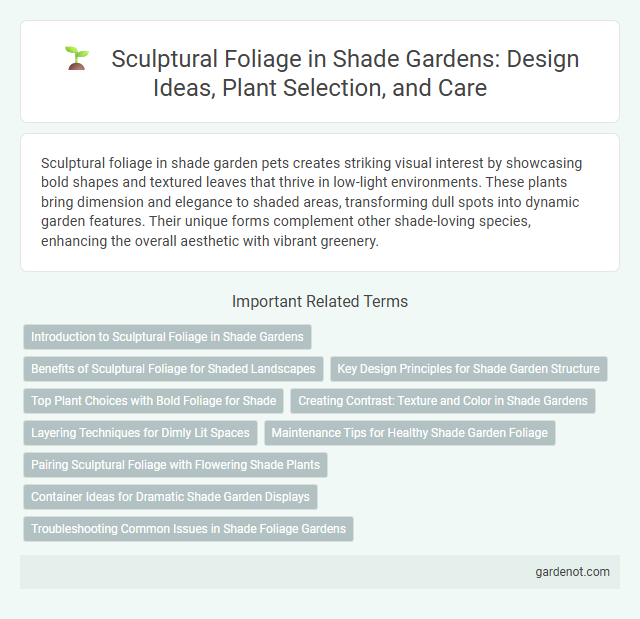Sculptural foliage in shade garden pets creates striking visual interest by showcasing bold shapes and textured leaves that thrive in low-light environments. These plants bring dimension and elegance to shaded areas, transforming dull spots into dynamic garden features. Their unique forms complement other shade-loving species, enhancing the overall aesthetic with vibrant greenery.
Introduction to Sculptural Foliage in Shade Gardens
Sculptural foliage in shade gardens introduces plants with bold, textured leaves that create visual interest despite limited sunlight. Varieties such as hostas, ferns, and elephant ears thrive in low-light conditions while providing dynamic shapes and rich greens. Incorporating sculptural foliage enhances depth and contrast, transforming shaded areas into captivating garden features.
Benefits of Sculptural Foliage for Shaded Landscapes
Sculptural foliage enhances shaded landscapes by adding texture and visual interest where sunlight is limited, creating dynamic focal points with bold leaf shapes and contrasting colors. Plants such as hostas, ferns, and heucheras thrive in low light, improving garden depth and structure while requiring minimal maintenance. These foliage varieties boost biodiversity by providing habitat and food for pollinators and beneficial insects, supporting ecosystem health in shaded garden areas.
Key Design Principles for Shade Garden Structure
Sculptural foliage plays a pivotal role in shade garden structure by providing bold texture, form, and visual interest amid low-light conditions. Emphasizing key design principles such as contrast, repetition, and scale enhances the spatial depth and balance through diverse leaf shapes and sizes. Selecting plants like hostas, ferns, and caladiums that thrive in shade ensures enduring structural presence and dynamic seasonal variation.
Top Plant Choices with Bold Foliage for Shade
Hosta varieties such as 'Sum and Substance' and 'Guacamole' boast large, bold leaves that create striking texture and vibrant contrast in shade gardens. Ferns like Athyrium niponicum 'Pictum' offer intricately patterned fronds that enhance depth and interest under low light conditions. Ligularia species, including 'The Rocket,' provide dramatic, broad leaves with rich green hues that thrive in moist, shaded environments, making them top choices for sculptural foliage in shaded landscapes.
Creating Contrast: Texture and Color in Shade Gardens
Sculptural foliage plays a crucial role in shade gardens by introducing bold texture and vivid color contrasts that enliven dimly lit spaces. Plants like hostas with their broad, variegated leaves and ferns with delicate fronds create striking visual interest and depth. Combining glossy, dark-leaved plants with matte, lighter-toned species enhances contrast, making the garden's contours and layers more pronounced.
Layering Techniques for Dimly Lit Spaces
Sculptural foliage in shade gardens thrives by employing layering techniques that maximize texture and depth in dimly lit spaces. Combining broadleaf plants like hostas with fine-textured ferns creates visual contrast and enhances spatial complexity, optimizing the garden's aesthetic appeal. Strategic placement of taller plants behind shorter, variegated foliage ensures dynamic light reflection and shadow play, enriching the overall ambiance.
Maintenance Tips for Healthy Shade Garden Foliage
Sculptural foliage plants like hostas, ferns, and caladiums thrive in shaded gardens with consistent moisture and well-draining soil to prevent root rot. Regularly remove dead or yellowing leaves to promote air circulation and reduce fungal diseases. Feeding with balanced, slow-release fertilizer during the growing season supports vibrant, healthy foliage and enhances the garden's textured appearance.
Pairing Sculptural Foliage with Flowering Shade Plants
Pairing sculptural foliage with flowering shade plants creates a dynamic contrast that enhances the visual appeal of a shade garden. Bold, textured leaves such as those of hostas or ferns complement vibrant blooms like astilbe or hellebores, adding depth and dimension to shaded areas. This combination not only improves garden aesthetics but also supports diverse plant health by balancing light and moisture needs.
Container Ideas for Dramatic Shade Garden Displays
Sculptural foliage such as hostas, ferns, and caladiums create dynamic textures and shapes perfect for dramatic shade garden containers. Select large, intricately shaped leaves like those of the Japanese painted fern or elephant ear plants to add visual intrigue. Elevate the display by combining contrasting foliage colors and heights in moss-lined ceramic or weathered terracotta pots for striking shade garden container ideas.
Troubleshooting Common Issues in Shade Foliage Gardens
Sculptural foliage in shade gardens often faces challenges such as poor growth and discoloration caused by insufficient light and excessive moisture. Addressing drainage problems by amending soil with organic matter and ensuring proper shade plant selection like hostas or ferns enhances overall foliage health. Regular monitoring for pests like slugs and fungal diseases, along with timely intervention using natural treatments, prevents common setbacks in shaded landscape designs.
Sculptural foliage Infographic

 gardenot.com
gardenot.com